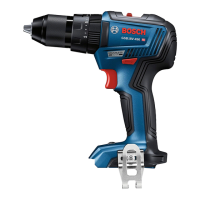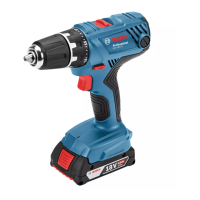14 SAVE THESE INSTRUCTIONS
Sanding and Polishing
Only use accessories
having Max. Rated RPM
equal to, or higher than the Max. Rated
RPM of the tool, as marked on the
nameplate. Using accessories with lower
RPM rating than Max. RPM of the tool, may
cause injury or damage to property.
Fine sanding and polishing re quire “touch”.
Select the most efficient speed.
When using polishing
bonnets, always be sure the
excess string that secures the bonnet is
tucked well within the bonnet during
operation.
Wire Brushes
1. Let the tips of a wire brush do the work.
Operate the brush with the lightest
pressure so only the tips of the wire
come in contact with the work.
2. If heavier pressures are used, the wires
will be overstressed, resulting in a wiping
action; and if this is continued, the life of
the brush will be shortened due to wire
fatigue.
3. Apply the brush to the work in such a way
that as much of the brush face as
possible is in full contact with the work.
Applying the side or edge of the brush to
the work will result in wire breakage and
shortened brush life.
Drilling Wood
Be certain workpiece is clamped or anchored
firm ly. Always apply pressure in a straight line
with the drill bit. Maintain enough pressure to
keep the drill “biting”.
When drilling holes in wood, twist bits can be
used. Twist bits may overheat unless pulled
out frequently to clear chips from flutes.
Use a “back-up” block of wood for work that is
likely to splinter, such as thin materials.
You will drill a cleaner hole if you ease up on
the pressure just before the bit breaks
through the wood. Then complete the hole
from the back side.
Drilling Metal
There are two rules for drilling hard materials.
First, the harder the material, the greater the
pres sure you need to apply to the tool.
Second, the harder the material, the slower
t
he speed. Here are a couple of tips for drilling
in metal. Lubri cate the tip of the bit
occasionally with cutting oil except when
drilling soft metals such as alu minum, cop per
or cast iron. If the hole to be drilled is fairly
large, drill a smaller hole first, then enlarge to
the required size, it’s often faster in the long
run. Main tain enough pressure to assure that
the bit does not just spin in the hole. This will
dull the bit and greatly shorten its life.
Drilling Masonry
Soft materials such as brick are relatively easy
to drill. Concrete however, will require much
more pressure to keep the bit from spinning.
Be sure to use carbide tip bits for all masonry
work.
CORRECT: Wire tips doing the work.
INCORRECT: Excessive pressure can cause wire breakage.
2610067277 GSR18V-490 06-21.qxp_GSB18V-490 6/2/21 3:12 PM Page 14

